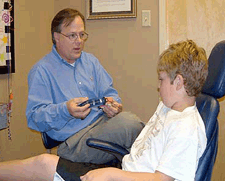المقالات
Panographic

We'll take a panaographic X-ray when we need to have a complete picture of your mouth. Because they produce an image of your entire mouth and jaw, panographic X-rays can detect receding bone levels (a sign of periodontal disease), abscesses, impacted wisdom teeth, sinus and jaw problems, tooth trauma, and other serious conditions that we would otherwise not be able to detect.
To prepare for a panographic X-ray, we'll cover your upper body with a lead apron. You'll rest your chin on a small padded platform, and the X-ray machine will rotate around your face in a smooth, constant motion. When your panographic X-ray is processed, we'll have an invaluable record of the current state of your oral health.
The camera rotates around you We use the latest techniques and equipment in order to ensure that your radiation exposure is minimized. The exposure you get from a modern panographic X-ray is equal to about ten days of exposure to natural background radiation. Because of the high-speed film we use, the exposure time is only a few seconds. Additionally, even if you've recently had X-rays taken of other parts of your body, a panographic X-ray does not add to that exposure.
